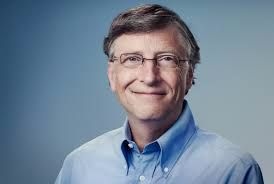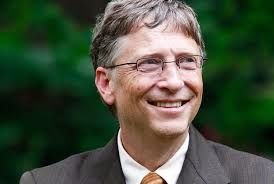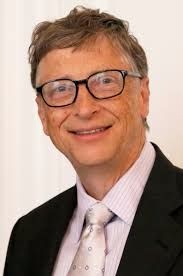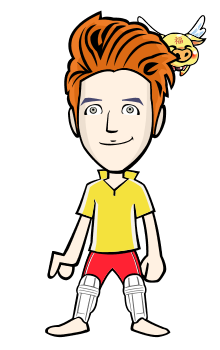Picture
About
Business magnate
William Henry "Bill" Gates III is an American business magnate, philanthropist, investor, and computer programmer. In 1975, Gates and Paul Allen co-founded Microsoft, which became the world's largest PC software company. Wikipedia
Born: October 28, 1955 (age 60), Seattle, Washington, United States
Net worth: 79.2 billion USD (2015) Forbes
Spouse: Melinda Gates (m. 1994)
Children: Jennifer Katharine Gates, Phoebe Adele Gates, Rory John Gates
Siblings: Libby Gates, Kristi Gates
Quotes
Success is a lousy teacher. It seduces smart people into thinking they can't lose.
Your most unhappy customers are your greatest source of learning.
As we look ahead into the next century, leaders will be those who empower others.
William Henry "Bill" Gates III (born October 28, 1955) is an American business magnate, philanthropist, investor, and computer programmer.[2][3] In 1975, Gates and Paul Allen co-founded Microsoft, which became the world's largest PC software company. During his career at Microsoft, Gates held the positions of chairman, CEO and chief software architect, and was the largest individual shareholder until May 2014.[4][a] Gates has authored and co-authored several books.
Starting in 1987, Gates was included in the Forbes list of the world's wealthiest people[7] and was the wealthiest from 1995 to 2007, again in 2009, and has been since 2014.[8] Between 2009 and 2014, his wealth doubled from US$40 billion to more thanUS$82 billion.[9] Between 2013 and 2014, his wealth increased by US$15 billion.[10] Gates is currently the wealthiest person in the world with a wealth of US$77.2 billion.[11]
Gates is one of the best-known entrepreneurs of the personal computer revolution. Gates has been criticized for his business tactics, which have been considered anti-competitive, an opinion which has in some cases been upheld by numerous court rulings.[12][13]Later in his career Gates pursued a number of philanthropic endeavors, donating large amounts of money to various charitable organizations and scientific research programs through the Bill & Melinda Gates Foundation, established in 2000.
Gates stepped down as Chief Executive Officer of Microsoft in January 2000. He remained as Chairman and created the position of Chief Software Architect for himself.[14] In June 2006, Gates announced that he would be transitioning from full-time work at Microsoft to part-time work, and full-time work at the Bill & Melinda Gates Foundation.[15] He gradually transferred his duties to Ray Ozzie, chief software architect and Craig Mundie, chief research and strategy officer.[16] Ozzie later left the company. Gates's last full-time day at Microsoft was June 27, 2008.[16] He stepped down as Chairman of Microsoft in February 2014, taking on a new post as technology advisor to support newly appointed CEO Satya Nadella.[17
Early life
Gates was born in Seattle, Washington on October 28, 1955. He is the son of William H. Gates, Sr.[b] and Mary Maxwell Gates. Gates' ancestral origin includes English, German, and Irish, Scots-Irish.[18][19] His father was a prominent lawyer, and his mother served on the board of directors for First Interstate BancSystem and the United Way. Gates's maternal grandfather was JW Maxwell, a national bank president. Gates has one elder sister, Kristi (Kristianne), and one younger sister, Libby. He was the fourth of his name in his family, but was known as William Gates III or "Trey" because his father had the "II" suffix.[20] Early on in his life, Gates's parents had a law career in mind for him.[21] When Gates was young, his family regularly attended a church of the Congregational Christian Churches, a Protestant Reformed denomination.[22][23][24] The family encouraged competition; one visitor reported that "it didn't matter whether it was hearts or pickleball or swimming to the dock ... there was always a reward for winning and there was always a penalty for losing".[25]
At 13, he enrolled in the Lakeside School, a private preparatory school.[26] When he was in the eighth grade, the Mothers Club at the school used proceeds from Lakeside School's rummage sale to buy a Teletype Model 33 ASR terminal and a block of computer time on a General Electric (GE) computer for the school's students.[27] Gates took an interest in programming the GE system in BASIC, and was excused from math classes to pursue his interest. He wrote his first computer program on this machine: an implementation of tic-tac-toe that allowed users to play games against the computer. Gates was fascinated by the machine and how it would always execute software code perfectly. When he reflected back on that moment, he said, "There was just something neat about the machine."[28] After the Mothers Club donation was exhausted, he and other students sought time on systems including DEC PDP minicomputers. One of these systems was a PDP-10 belonging to Computer Center Corporation (CCC), which banned four Lakeside students – Gates, Paul Allen, Ric Weiland, and Kent Evans – for the summer after it caught them exploiting bugs in the operating system to obtain free computer time.[29][30]
At the end of the ban, the four students offered to find bugs in CCC's software in exchange for computer time. Rather than use the system via Teletype, Gates went to CCC's offices and studied source code for various programs that ran on the system, including programs in Fortran, Lisp, and machine language. The arrangement with CCC continued until 1970, when the company went out of business. The following year, Information Sciences, Inc. hired the four Lakeside students to write a payroll program in Cobol, providing them computer time and royalties. After his administrators became aware of his programming abilities, Gates wrote the school's computer program to schedule students in classes. He modified the code so that he was placed in classes with "a disproportionate number of interesting girls."[31] He later stated that "it was hard to tear myself away from a machine at which I could so unambiguously demonstrate success."[28] At age 17, Gates formed a venture with Allen, called Traf-O-Data, to make traffic counters based on theIntel 8008 processor.[32] In early 1973, Bill Gates served as a congressional page in the U.S. House of Representatives.[33]
Gates graduated from Lakeside School in 1973, and was a National Merit Scholar.[34] He scored 1590 out of 1600 on the SAT[35] and enrolled at Harvard College in the autumn of 1973.[36] While at Harvard, he met Steve Ballmer, who would later succeed Gates as CEO of Microsoft.[37]
The Poker Room in Currier Houseat Harvard College
In his sophomore year, Gates devised an algorithm for pancake sorting as a solution to one of a series of unsolved problems[38] presented in a combinatorics class by Harry Lewis, one of his professors. Gates's solution held the record as the fastest version for over thirty years;[38][39] its successor is faster by only one percent.[38] His solution was later formalized in a published paper in collaboration with Harvard computer scientist Christos Papadimitriou.[40]
Gates did not have a definite study plan while a student at Harvard[41] and spent a lot of time using the school's computers. Gates remained in contact with Paul Allen, and he joined him at Honeywell during the summer of 1974.[42] The following year saw the release of the MITS Altair 8800 based on the Intel 8080 CPU, and Gates and Allen saw this as the opportunity to start their own computer software company.[43] Gates dropped out of Harvard at this time. He had talked this decision over with his parents, who were supportive of him after seeing how much Gates wanted to start a company.[41]
Microsoft
fter reading the January 1975 issue of Popular Electronics that demonstrated the Altair 8800, Gates contacted Micro Instrumentation and Telemetry Systems (MITS), the creators of the new microcomputer, to inform them that he and others were working on a BASICinterpreter for the platform.[44] In reality, Gates and Allen did not have an Altair and had not written code for it; they merely wanted to gauge MITS's interest. MITS president Ed Roberts agreed to meet them for a demo, and over the course of a few weeks they developed an Altair emulator that ran on a minicomputer, and then the BASIC interpreter. The demonstration, held at MITS's offices in Albuquerque, was a success and resulted in a deal with MITS to distribute the interpreter as Altair BASIC. Paul Allen was hired into MITS,[45] and Gates took a leave of absence from Harvard to work with Allen at MITS in Albuquerque in November 1975. They named their partnership "Micro-Soft" and had their first office located in Albuquerque.[45] Within a year, the hyphen was dropped, and on November 26, 1976, the trade name "Microsoft" was registered with the Office of the Secretary of the State of New Mexico.[45] Gates never returned to Harvard to complete his studies.
Microsoft's Altair BASIC was popular with computer hobbyists, but Gates discovered that a pre-market copy had leaked into the community and was being widely copied and distributed. In February 1976, Gates wrote an Open Letter to Hobbyists in the MITS newsletter in which he asserted that more than 90% of the users of Microsoft Altair BASIC had not paid Microsoft for it and by doing so the Altair "hobby market" was in danger of eliminating the incentive for any professional developers to produce, distribute, and maintain high-quality software.[46] This letter was unpopular with many computer hobbyists, but Gates persisted in his belief that software developers should be able to demand payment. Microsoft became independent of MITS in late 1976, and it continued to develop programming language software for various systems.[45] The company moved from Albuquerque to its new home in Bellevue, Washington, on January 1, 1979.[44]
During Microsoft's early years, all employees had broad responsibility for the company's business. Gates oversaw the business details, but continued to write code as well. In the first five years, Gates personally reviewed every line of code the company shipped, and often rewrote parts of it as he saw fit.[47]
IBM partnership
IBM approached Microsoft in July 1980, regarding its upcoming personal computer, the IBM PC.[48] The computer company first proposed that Microsoft write the BASIC interpreter. When IBM's representatives mentioned that they needed an operating system, Gates referred them to Digital Research (DRI), makers of the widely used CP/Moperating system.[49] IBM's discussions with Digital Research went poorly, and they did not reach a licensing agreement. IBM representative Jack Sams mentioned the licensing difficulties during a subsequent meeting with Gates and told him to get an acceptable operating system. A few weeks later, Gates proposed using 86-DOS (QDOS), an operating system similar to CP/M that Tim Paterson of Seattle Computer Products (SCP) had made for hardware similar to the PC. Microsoft made a deal with SCP to become the exclusive licensing agent, and later the full owner, of 86-DOS. After adapting the operating system for the PC, Microsoft delivered it to IBM as PC DOS in exchange for a one-time fee of $50,000.[50]
Gates did not offer to transfer the copyright on the operating system, because he believed that other hardware vendors would clone IBM's system.[50] They did, and the sales ofMS-DOS made Microsoft a major player in the industry.[51] Despite IBM's name on the operating system the press quickly identified Microsoft as being very influential on the new computer. PC Magazine asked if Gates were "the man behind the machine?",[48] and InfoWorld quoted an expert as stating "it's Gates' computer".[52] Gates oversaw Microsoft's company restructuring on June 25, 1981, which re-incorporated the company in Washington state and made Gates President of Microsoft and the Chairman of the Board.[44]



